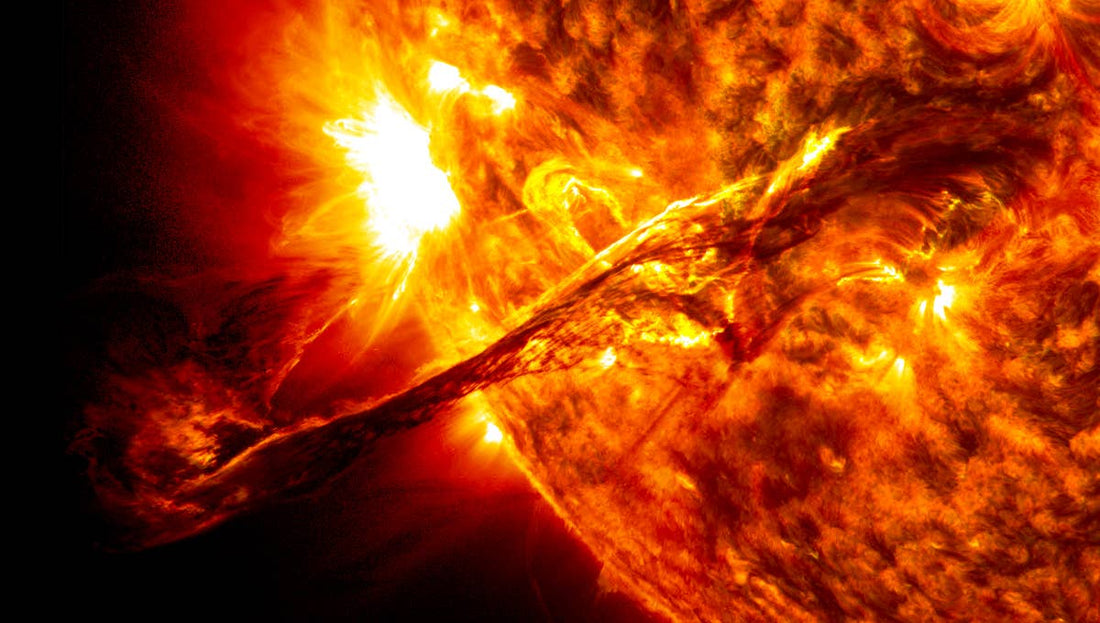
Our Largest Solar Telescope Snaps The Sun's Hole In Delightful Detail
Share
Sunspots are exciting.
They're patches of dark, discoloured surface where the magnetic field is about 2,500 times stronger than Earth's.
This focussed magnetism is much higher than anywhere else on the sun. Plus, the surrounding atmospheric pressure decreases.
Hence the noticeable "hole" that appears.
And now, the easily Daniel K. Inouye Solar Telescope - the largest sun-spotting telescope on Earth - has snapped the highest quality detail of a sunspot in human history.

It mightn't look like much, but this seemingly small image is 16,100 km across and the spot pictured could easily house Earth inside it.
The photo - taken on January 28th and recently released to the public - shows advanced details of structures that are just 20km in size.
For perspective, the Sun's circumference is around 4,366,813km. Meaning the image is showing us 0.000458% of the Sun.
The darkness shown is the manifestation of magnetic concentration that blocks the heat within the Sun from reaching the surface. Even so, the cooler hole created is still 4,100 degrees Celsius. The feathering from the middle outwards is bits of hot and cool gas bubbling up to the surface from below.

The NSF - who run the day-to-day operations of the telescope managed to capture the photo before the facility reached completion.
"We can now point the world's most advanced solar telescope at the sun to capture and share incredibly detailed images and add to our scientific insights about the sun's activity," Matt Mountain, president of the Association of Universities for Research in Astronomy, which manages the Inouye Solar Telescope, said in a statement.
You'll find the Daniel K. Inouye Solar Telescope a the top of Maui's Haleakalā mountain in Hawaii.
The sun-staring telescope, affectionately nicknamed DKIST, happens to be on a mountain whose name translates to 'house of the sun,' and named after the Hawaiian senator who served the state for nearly five decades.
"It is literally the greatest leap in humanity's ability to study the Sun from the ground since Galileo's time," said astronomer Jeff Kuhn of the University of Hawaiʻi at Mānoa's Institute for Astronomy.
"It's a big deal."

The telescope sits on a wide, rotational base similar to a lazy susan. This allows the dome and base to pivot and take aim at the Sun as it tracks the sky. Beneath the base is a labyrinth of electrical wiring for the 120 actuators that maintain a level mirror when observing. Without them, observation, let alone photography to the degree of the photo mentioned, would be impossible.

While it might look like a traditional telescope, the DKIST has a large arm that deals with a large amount of heat instead of a focal mirror. Sunlight reflects off the telescope mirror and into the top end optical assembly on the arm. Then, 95% of heat is absorbed by a piece of liquid-cooled metal called a "heat stop,". A sliver of light passes through to hit smaller cooled mirrors before they're transferred to a team of mirrors in the laboratory below.
You might remember the DKIST from this image.
Each flaming convection granule could fit around 10 average-sized European countries within. Or if you're American, one full-grown Texas could easily fit within one.
These buds from the Sun are the roots of magnetic fields that extend approximately 37014912000km into space, covering the entire solar system and beyond.
The magnetic fields emanating from the Sun have the potential to create solar storms capable of knocking out power grids and sending humanity back to the stone age. Thankfully, these are extremely rare.
Still, smaller solar storms can affect communications and navigation systems on Earth. Plus they generate spectacular auroras like the Northern Lights.
And with the help of DKIST, we can begin to predict space weather generated by the Sun a little better.

"On Earth, we can predict if it is going to rain pretty much anywhere in the world very accurately, and space weather just isn't there yet," said Matt Mountain.
"Our predictions lag behind terrestrial weather by 50 years, if not more. What we need is to grasp the underlying physics behind space weather, and this starts at the Sun, which is what the Inouye Solar Telescope will study over the next decades."
"It's all about the magnetic field," said Thomas Rimmele, director of the Inouye Solar Telescope.
"To unravel the Sun's biggest mysteries, we have to not only be able to clearly see these tiny structures from 93 million miles (150 million kilometres) away, but very precisely measure their magnetic field strength and direction near the surface and trace the field as it extends out into the million-degree corona, the outer atmosphere of the Sun."
#Space_Aus




